1996 CHEVROLET CAVALIER air condition
[x] Cancel search: air conditionPage 301 of 372
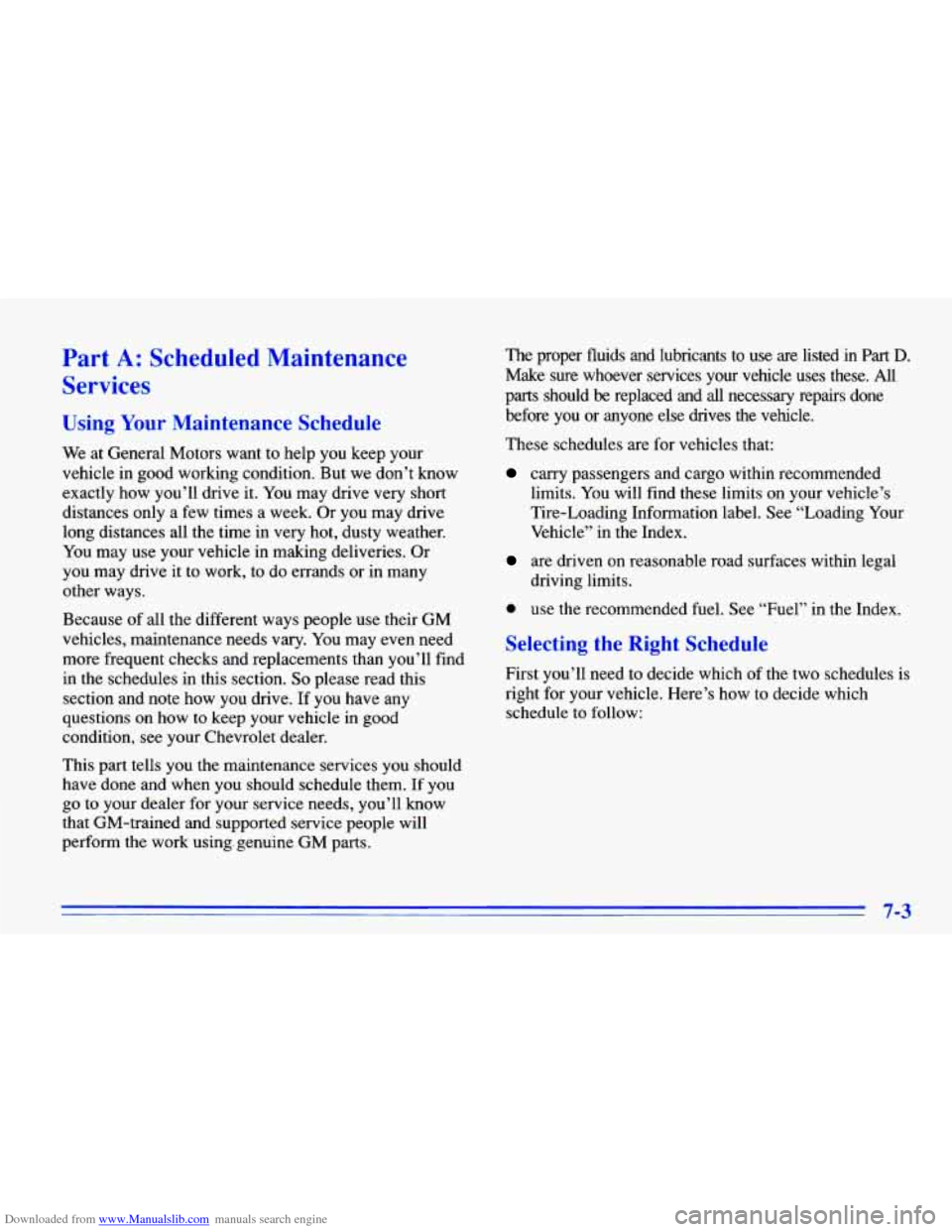
Downloaded from www.Manualslib.com manuals search engine Part A: Scheduled Maintenance
Services
Using Your Maintenance Schedule
We at General Motors want to help you keep your
vehicle in good working condition. But we don’t know
exactly how you’ll drive it. You may drive very short
distances only a few times a week.
Or you may drive
long distances all the time in very hot, dusty weather.
You may use your vehicle
in making deliveries. Or
you may drive it to work, to do errands or in many
other ways.
Because of all the different ways people use their
GM
vehicles, maintenance needs vary. You may even need
more frequent checks and replacements than you’ll find
in the schedules in this section.
So please read this
section and note how you drive. If you have any
questions
on how to keep your vehicle in good
condition, see your Chevrolet dealer.
This
part tells you the maintenance services you should
have done and when you should schedule them. If you
go to your dealer for your service needs, you’ll know
that GM-trained and supported service people will
perform the work using. genuine
GM parts, The proper fluids and lubricants to use are listed
in Part D.
Make sure whoever services your vehicle uses these. All
parts should be replaced and all necessary repairs done
before you or anyone else dnves the vehicle.
These schedules are for vehicles that:
carry passengers and cargo within recommended
limits. You will find these limits on your vehicle’s
Tire-Loading Information label. See “Loading Your
Vehicle” in the Index.
are driven on reasonable road surfaces within legal
driving limits.
0 use the recommended fuel. See “Fuel’’ in the Index.
Selecting the Right Schedule
First you’ll need to decide which of the two schedules is
right for your vehicle. Here’s how to decide which
schedule to follow:
7-3
Page 302 of 372
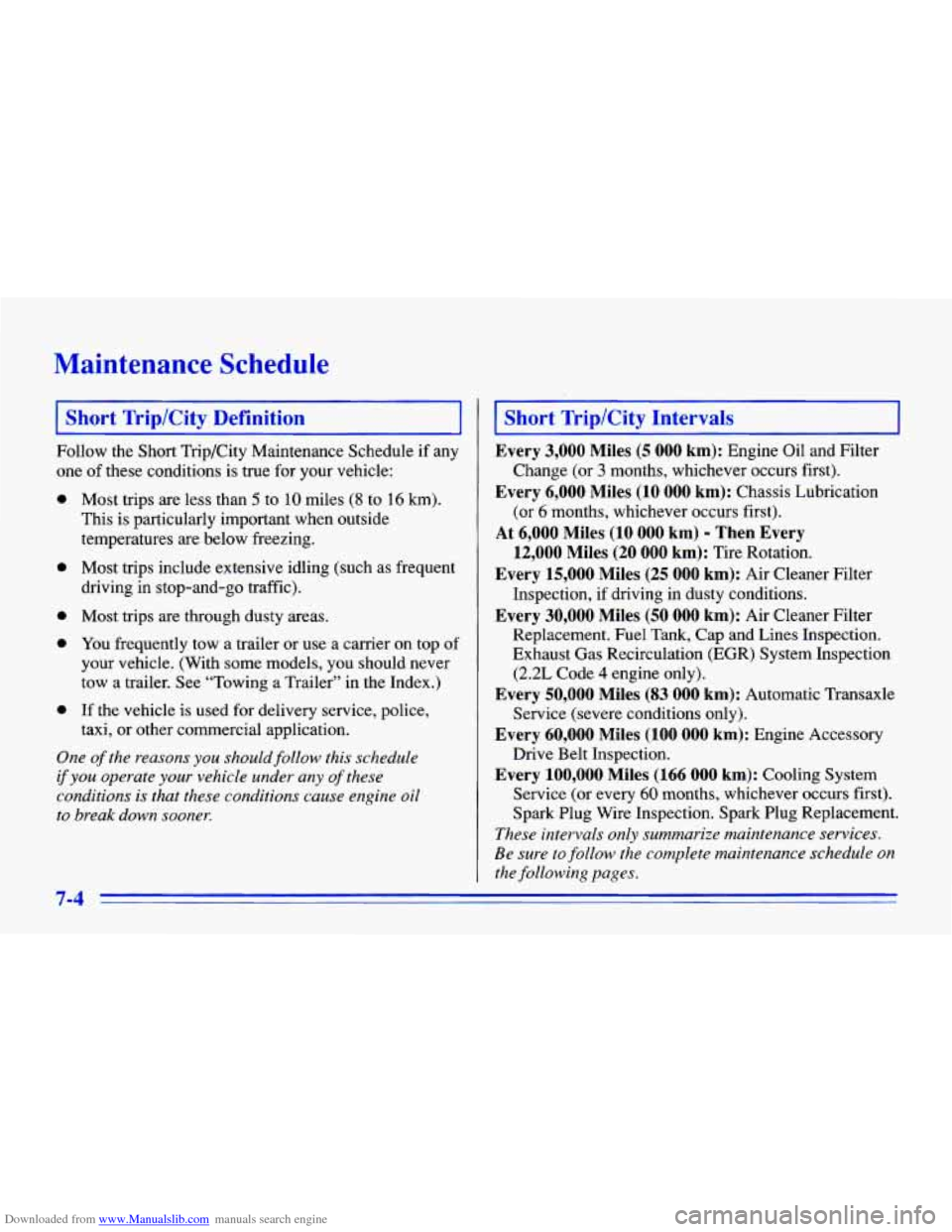
Downloaded from www.Manualslib.com manuals search engine Maintenance Schedule
I Short Trip/City Definition
~~
I
Follow the Short Trip/City Maintenance Schedule if any
one of these conditions is true for your vehicle:
0
0
e
0
e
Most trips are less than 5 to 10 miles (8 to 16 km).
This is particularly important when outside
temperatures are below freezing.
Most trips include extensive idling (such as frequent
driving in stop-and-go traffic).
Most trips
are through dusty areas.
You frequently tow
a trailer or use a carrier on top of
your vehicle. (With some models, you should never
tow a trailer. See “Towing a Trailer” in the Index.)
If the vehicle is used for delivery service, police,
taxi, or other commercial application.
One of the reasons you should follow this schedule
if you operate your vehicle under any of these
conditions is that these conditions cause engine oil
to break down sooner.
Short Trip/City Intervals
Every 3,000 Miles (5 000 km): Engine Oil and Filter
Change (or
3 months, whichever occurs first).
Every 6,000 Miles (10 000 km): Chassis Lubrication
(or
6 months, whichever occurs first).
At 6,000 Miles (10 000 km) - Then Every
12,000 Miles (20 000 km): Tire Rotation.
Every 15,000 Miles (25 000 km): Air Cleaner Filter
Inspection,
if driving in dusty conditions.
Every 30,000 Miles (50 000 km): Air Cleaner Filter
Replacement. Fuel Tank, Cap and Lines Inspection.
Exhaust Gas Recirculation (EGR) System Inspection
(2.2L Code 4 engine only).
Every 50,000 Miles (83 000 km): Automatic Transaxle
Service (severe conditions only).
Every 60,000 Miles (100 000 km): Engine Accessory
Drive Belt Inspection.
Every 100,000 Miles (166 000 km): Cooling System
Service (or every
60 months, whichever occurs first).
Spark Plug Wire Inspection. Spark Plug Replacement.
These intervals only summarize maintenance services.
Be sure to follow the complete maintenance schedule
on
the following pages.
7-4
Page 303 of 372
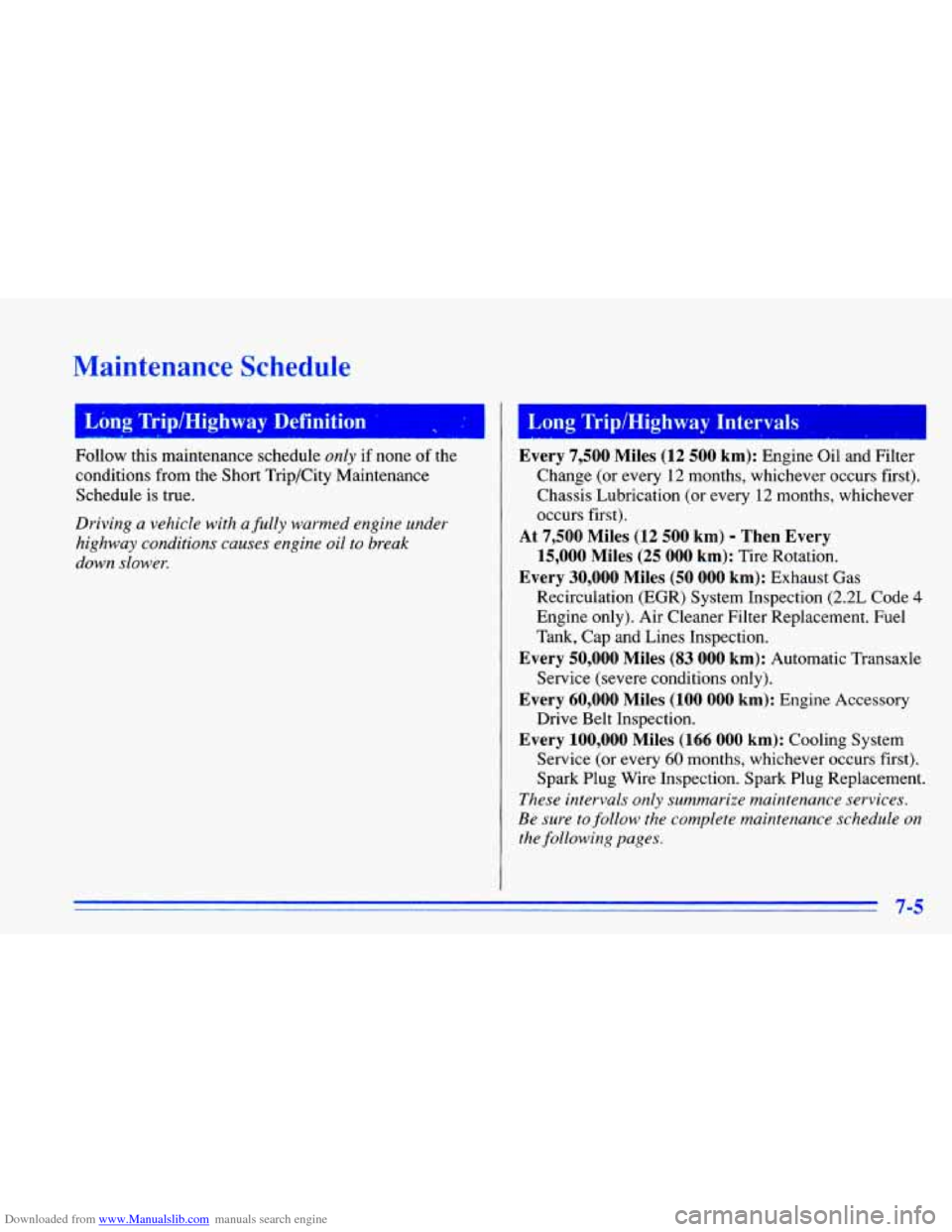
Downloaded from www.Manualslib.com manuals search engine Maintenance Schedule
Long Trip/Highway Definition h Long TriplHighway Intervals
Follow this maintenance schedule only if none of LIIG
conditions from the Short Trip/City Maintenance
Schedule is true.
Driving a vehicle with a fully warmed engine under
highway conditions causes engine oil to break
down slower.
nvery 7,500 Miles (12 500 km): Engine Oil and Filter
Change (or every
12 months, whichever occurs first).
Chassis Lubrication (or every
12 months, whichever
occurs first).
At 7,500 Miles (12 500 km) - Then Every
15,000 Miles (25 000 km): Tire Rotation.
Every 30,000 Miles (50 000 km): Exhaust Gas
Recirculation (EGR) System Inspection (2.2L Code 4
Engine only). Air Cleaner Filter Replacement. Fuel
Tank, Cap and Lines Inspection.
Every 50,000 Miles (83 000 km): Automatic Transaxle
Service (severe conditions only).
Every 60,000 Miles (100 000 km): Engine Accessory
Drive Belt Inspection.
Every 100,000 Miles (166 000 km): Cooling System
Service (or every
60 months, whichever occurs first).
Spark Plug Wire Inspection. Spark Plug Replacement.
These intervals only summarize maintenance services.
Be sure
to follow the complete maintenance schedule on
the following pages.
7-5
Page 306 of 372
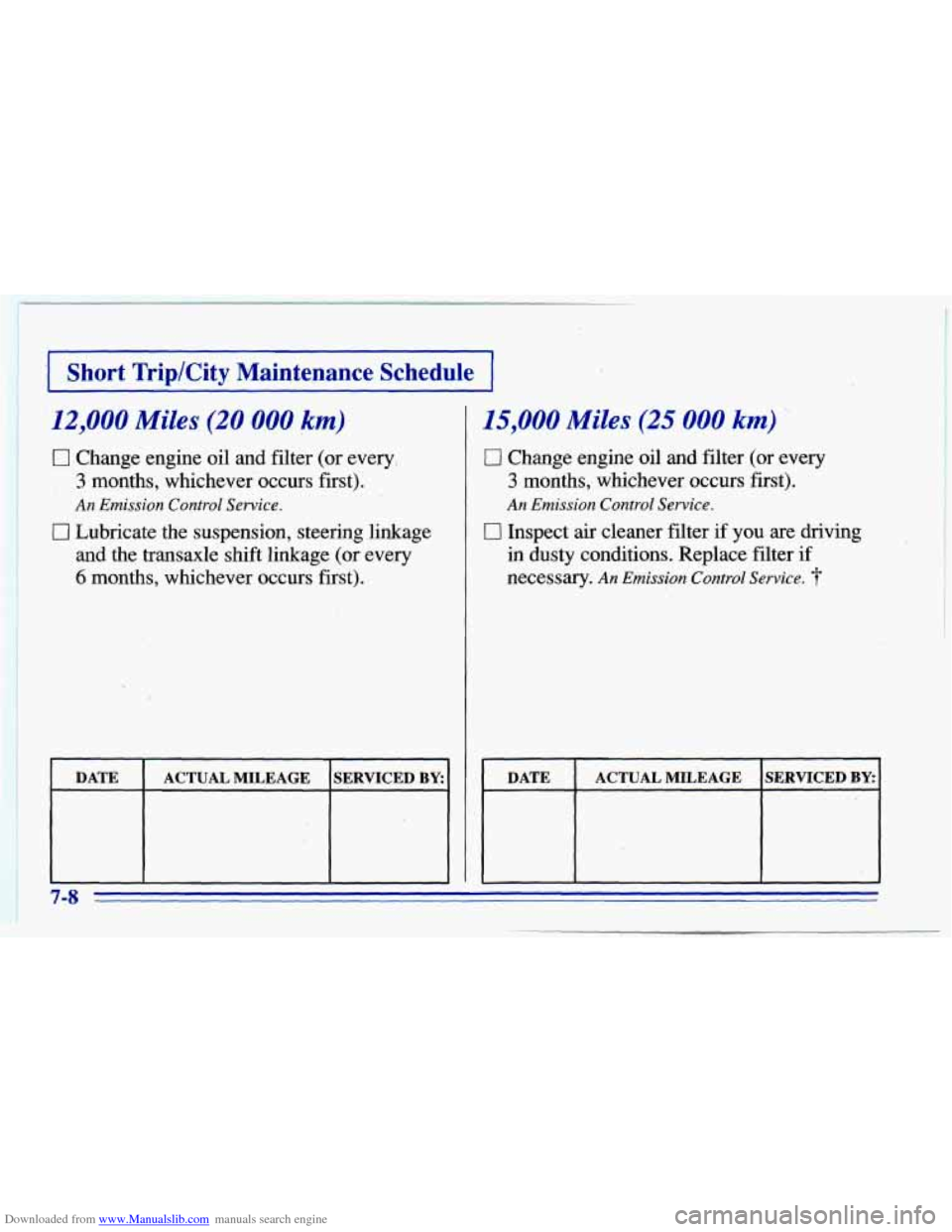
Downloaded from www.Manualslib.com manuals search engine ~ __ ~
'bhort Trip/City Maintenance Schedule I
12,000 Miles (20 000 km)
0 Change
engine oil and filter (or every,
3 months, whichever-occurs first).
An Emission Control Service.
0 Lubricate the suspension, steering linkage
and
the transaxle shift linkage (or every
6 months, whichever occurs first).
15,000 Miles (25 000 km) '
0 Change engine oil and filter (or every
3 months, whichever occurs first).
An Emission Control Service.
0 Inspect air cleaner filter if you are driving
in dusty conditions. Replace filter
if
necessary. An Emission Control Service.
DATE SERVICED BY: ACTUAL MILEAGE
7-8
Page 312 of 372
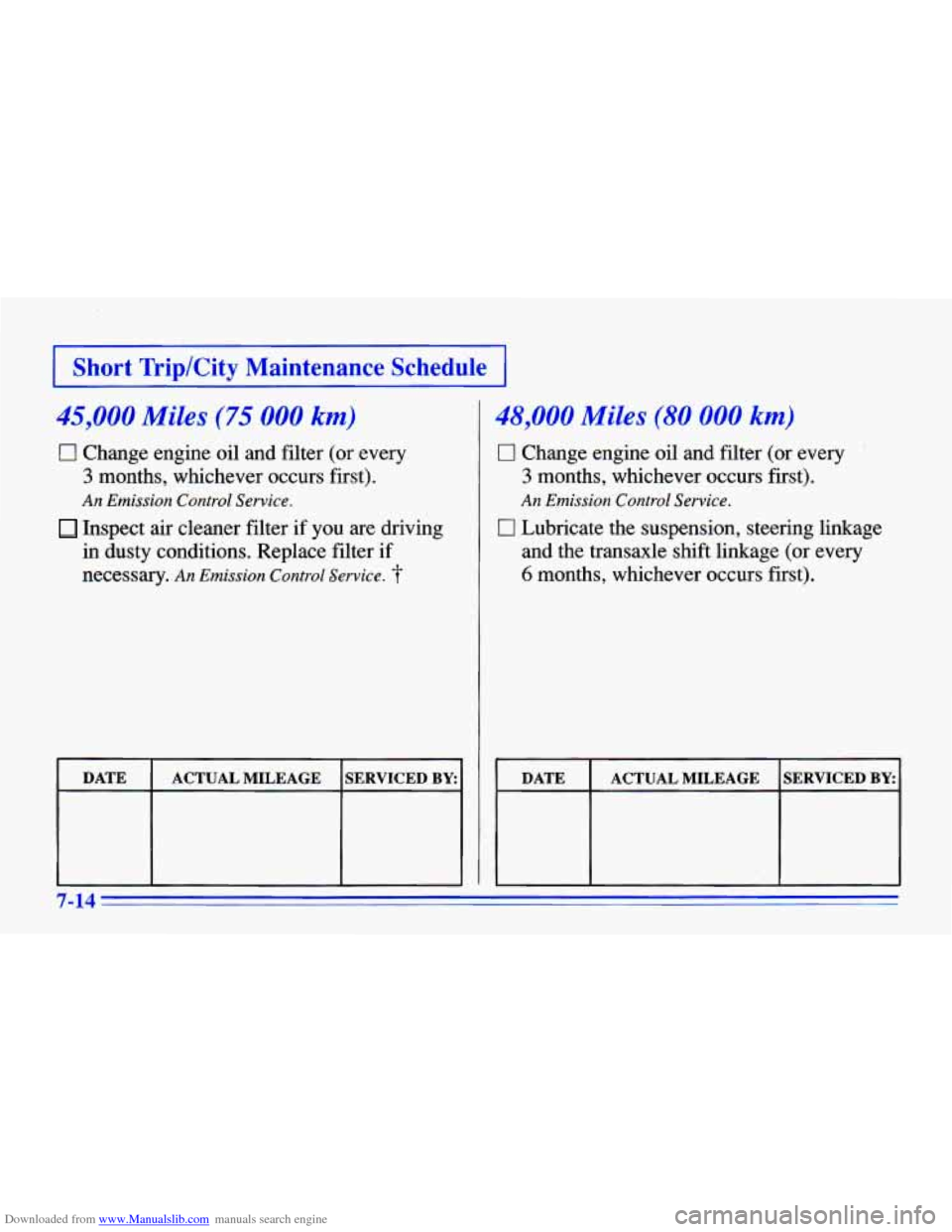
Downloaded from www.Manualslib.com manuals search engine I Short Trip/City Maintenance Schedule I
45,000 Miles (75 000 km)
0 Change engine oil and filter (or every
3 months, whichever occurs first).
An Emission Control Service.
Inspect air cleaner filter if you are driving
in dusty conditions. Replace filter
if
necessary. An Emission Control Service. 3-
DATE
SERVICED BY: ACTUAL MILEAGE
48,000 Miles (80 000 km)
0 Change engine oil and filter (or every
3 months, whichever occurs first).
An Emission Control Service.
0 Lubricate the suspension, steering linkage
and the transaxle shift linkage (or every
6 months, whichever occurs first).
DATE ACTUAL MILEAGE SERVICED BY:
7-14
Page 318 of 372

Downloaded from www.Manualslib.com manuals search engine I Short Trip/City Maintenance Schedule I
72,000 Miles (120 000 km)
0 Change engine oil and filter (or every
3 months, whichever occurs first).
An Emission Control Service.
0 Lubricate the suspension, steering linkage
and the transaxle shift linkage (or every
6 months, whichever occurs first).
75,000 Miles (125 000 km)
Change engine oil and filter (or every
3 months, whichever occurs first).
An Emission Control Service.
0 Inspect air cleaner filter if you are driving
in dusty conditions. Replace filter if
necessary.
An Emission Control Sewice. 3-
DATE SERVICED BY ACTUAL MILEAGE
7-20
Page 340 of 372
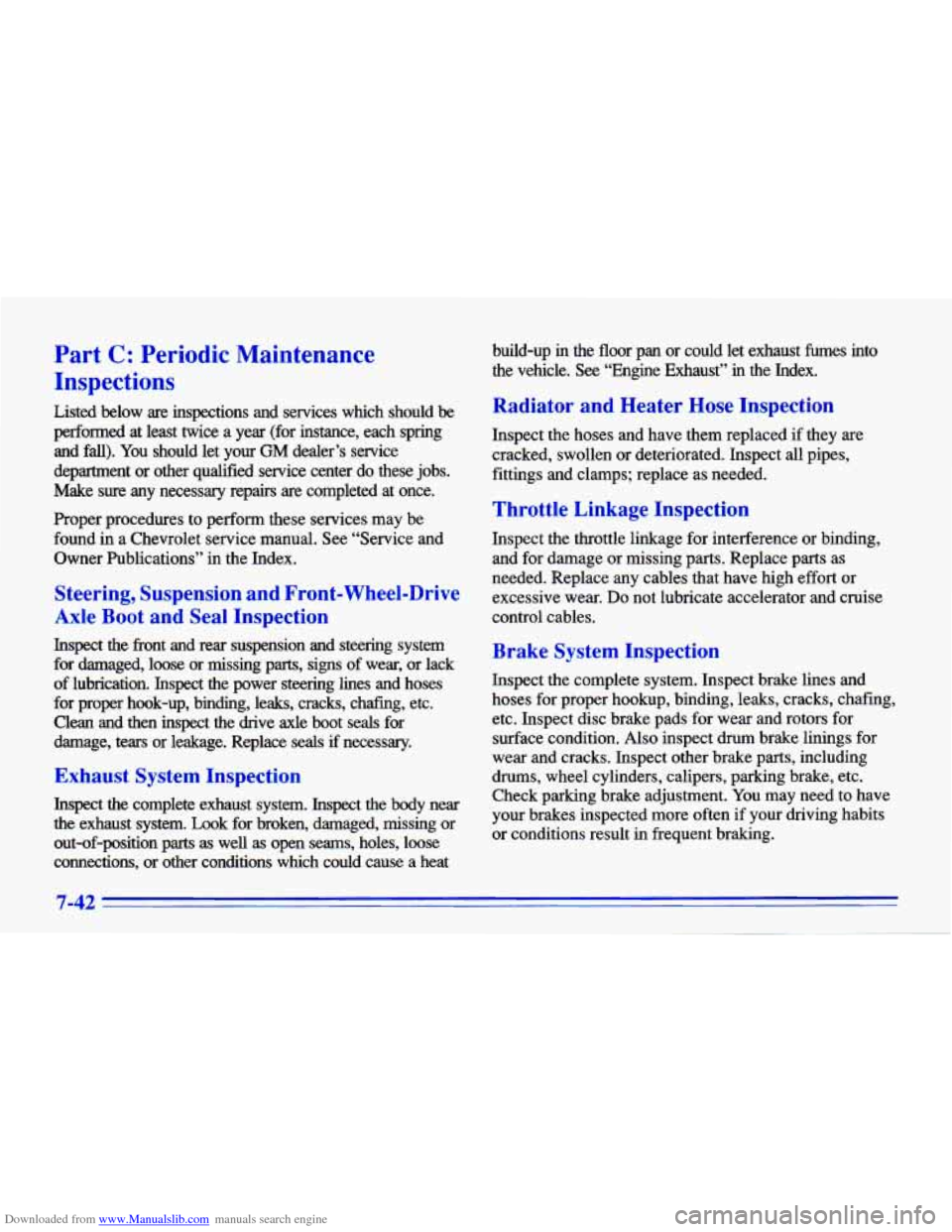
Downloaded from www.Manualslib.com manuals search engine Part C: Periodic Maintenance
Inspections
Listed below are inspections and services which should be
performed at least twice a year (for instance, each spring
and
fall). You should let your GM dealer’s service
department or other qualified service center do these jobs.
Make sure any necessary repairs are completed at once.
Proper procedures to perform these services may be
found
in a Chevrolet service manual. See “Service and
Owner Publications” in the Index.
Steering, Suspension and Front-Wheel-Drive
Axle
Boot and Seal Inspection
Inspect the front and rear suspension and steering system
for damaged, loose or missing parts, signs
of wear, or lack
of lubrication. Inspect the power steering lines and hoses
for proper hook-up, binding, leaks, cracks, chafing, etc.
Clean and then inspect the drive axle boot seals for
damage, tears or leakage. Replace seals
if necessary.
Exhaust System Inspection
Inspect the complete exhaust system. Inspect the body near
the exhaust system. Look for broken, damaged, missing or
out-of-position
parts as well as open seams, holes, loose
connections, or other conditions
which could cause a heat build-up in the floor pan or could let exhaust fumes into
the vehicle, See “Engine Exhaust”
in the Index.
Radiator and Heater Hose Inspection
Inspect the hoses and have them replaced if they are
cracked, swollen or deteriorated. Inspect all pipes,
fittings and clamps; replace as needed.
Throttle Linkage Inspection
Inspect the throttle linkage for interference or binding,
and for damage or missing parts. Replace parts as
needed. Replace any cables that have high effort or
excessive wear.
Do not lubricate accelerator and cruise
control cables.
Brake System Inspection
Inspect the complete system. Inspect brake lines and
hoses for proper hookup, binding, leaks, cracks, chafing, etc. Inspect disc brake pads for wear and rotors for
surface condition.
Also inspect drum brake linings for
wear and cracks. Inspect other brake parts, including
drums, wheel cylinders, calipers, parking brake, etc.
Check parking brake adjustment. You may need to have
your brakes inspected more often if your driving habits
or conditions result
in frequent braking.
7-42
Page 356 of 372

Downloaded from www.Manualslib.com manuals search engine Service Manuals
Service manuals contain diagnostic and repair
information for all chassis and body systems. They
may be useful for owners who wish to get a greater
understanding of their vehicle. They are also useful for
owners with the appropriate skill level or training who
wish to perform “do-it-yourself” service. These are
authentic General Motors service manuals meant for
professional, qualified technicians.
Service Bulletins
Service bulletins covering various subjects are regularly
sent to all General Motors dealerships. GM monitors
product performance in the field. When service methods
are found which promote better service on
GM vehicles,
bulletins are created to help the technician perform
better service. Service bulletins may involve any number of
vehicles. Some will describe inexpensive
service; others will describe expensive service.
Some
will advise of new or unexpected conditions, and others
may help avoid future costly repairs. Service bulletins
are meant for qualified technicians.
In some cases
bulletins refer to service manuals, specialized
tools,
equipment and safety procedures necessary to service
the vehicle. Since these bulletins are issued throughout
the model year and beyond, an index
is required and
published quarterly to help identify specific bulletins.
Subscriptions are available.
You can order an index at
the toll-free numbers listed previously, or ask a GM
dealer to see an index or individual bulletin.
Owner Publications
Owner’s manuals, warranty folders and various owner
assistance booklets provide owners with general
operation and maintenance information.
8-10